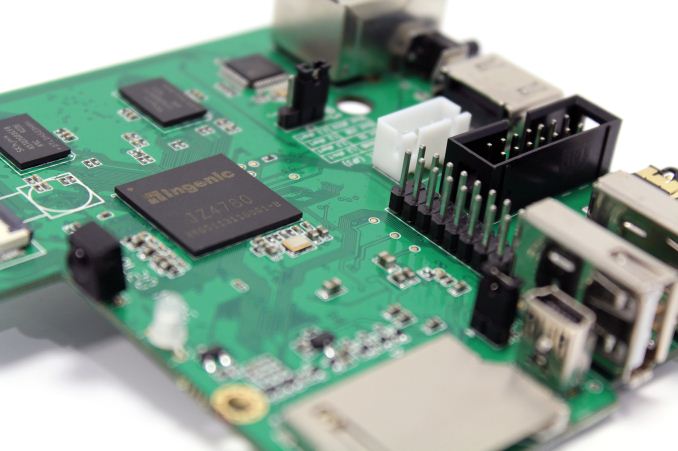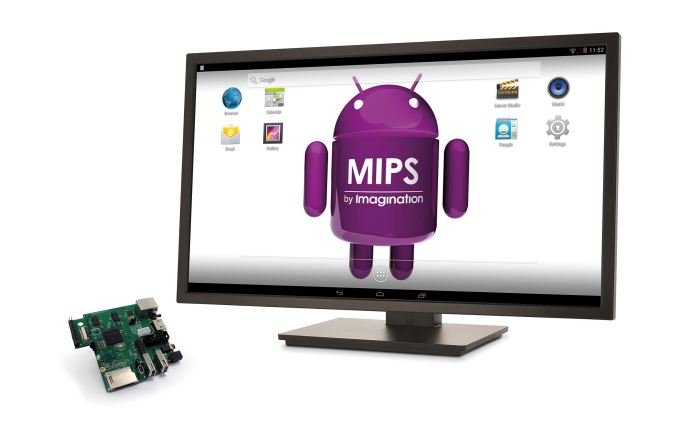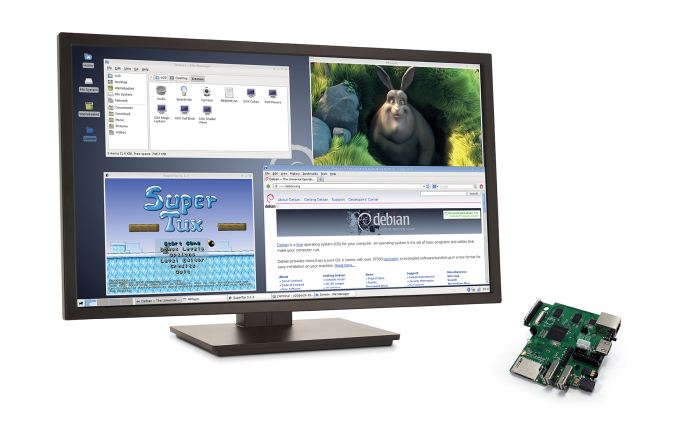Imagination Launches Creator CI20 Development Board
by Stephen Barrett on December 8, 2014 9:00 AM EST
Last week Imagination launched the Creator CI20 development board. This device is quite interesting because of the combination of architecture, features, developer support, form factor, and pricing. It also has some historical significance as it houses the first SoC to combine a MIPS CPU with PowerVR graphics. Imagination (the company behind PowerVR) purchased MIPS Technologies in February of 2013, and now the fruit of that investment can be found in silicon. That SoC is the Ingenic JZ4780. Ingenic is also known for the development of the Newton platform and XBurst CPUs.
At a high level, the easiest way to describe the CI20 is Raspberry Pi on steroids. Or perhaps this is what the Raspberry Pi could have been if redesigned two years later with about 60% more cost and a larger PCB size budget. This was clearly a target of Imagination as the CI20 contains the exact same expansion connector as the Raspberry Pi.
| Imagination Creator CI20 | Raspberry Pi Model B+ | |
| SoC | Ingenic JZ4780 | Broadcom BCM2835 |
| CPU | Dual 1.2GHz XBurst (MIPS32 instruction set) |
700 MHz ARM1176JZF-S (ARM11 family, ARMv6 instruction set) |
| GPU | PowerVR SGX 540 @ Unknown MHz | Broadcom VideoCore IV @ 250 MHz |
| Memory | 1GB DDR3 | 512MB DDR2 |
| USB | 1x USB OTG (A and Mini connectors) 1x USB Host |
4 USB 2.0 Host |
| Camera Interface | 24-pin connector (ITU-R BT.645) | 15-pin MIPI (CSI) connector |
| Video Output | HDMI 1.4a | HDMI 1.3a Composite video 3.5mm jack |
| Audio In | 3.5mm jack shared with output | via I²S interface |
| Audio Output | HDMI 3.5mm jack shared with input |
HDMI 3.5mm jack I²S interface |
| Storage | 8GB NAND 1x full SD slot 1x SD slot via expansion header |
via MicroSD |
| Network | 10/100 Ethernet 2.4GHz WiFi b/g/n + BT 4.0 (BCM4330) |
10/100 Ethernet |
| IR | Input (IRM-2638A) | - |
| Max Power Consumption | 4 Watts | 3 Watts |
| Power Connector | 5V barrel connector | MicroUSB |
| Size | Approx. 90mm x 95mm (3.54 in x 3.74 in) | 85.60 mm × 56.5 mm (3.37 in × 2.22 in) |
| Price | $65 or £50 | $35 without MPEG2 and VC1 codecs $40.60 with MPEG2 and VC1 codecs |
(Update 2/3/2015: Creator CI20 non-eval production units shipped with 8GB of NAND)
As you can see from the above table, the CI20 is in a completely different league when it comes to technical specifications. A much more powerful SoC, featuring MIPS and PowerVR, headlines the CI20, but the wealth of interfaces combined with improved storage/memory completes an impressive package for the price. Both the Raspberry Pi and the CI20 feature similar encode and decode support, except the pricing for the CI20 includes licenses to do so. Also, the CI20 supports 1080p60 decode, an upgrade over the 1080p30 of the Raspberry Pi.
For the software side of things, Imagination provides images for the CI20 of both Android Kitkat 4.4.4, Debian 7, Gentoo Linux, Yacto Sato, and Angstrom. Arch and OpenWRT are works in progress. For home media center users, there has also been some investigation running XBMC with Debian on the CI20.
I personally use XBMC on a Raspberry Pi at home. I requested a CI20 review unit from Imagination and received it this past Friday. I plan on doing some performance and power measurements on the device for a future article. Those interested in acquiring a CI20 can preorder (shipping at end of January) at the Imagination Store and enter a giveaway from Imagination.













27 Comments
View All Comments
alexvoica - Tuesday, December 9, 2014 - link
It means that this processor has been designed for entry level devices (affordable tablets, low cost media players, etc.), therefore those design choices have implications in terms of performance.BedfordTim - Monday, December 8, 2014 - link
It isn't my area, but the ODroid XU3 might be a better bet. to go up against the Jetsonddriver - Monday, December 8, 2014 - link
Jetson is faster and has better features than XU3, and although more expensive it is a better bargain. The one downside I see to it, the board is huge compared to the XU3.Samus - Monday, December 8, 2014 - link
Nice, keep us posted StephenLostAlone - Monday, December 8, 2014 - link
This seems to be in a weird place. It's more powerful than other boards certainly, but it's also not the most powerful on the market. The onboard wireless and storage is nice, but then you have to pay to get them. I'm not thrilled about a barrel connector over powering from micro USB too. This is certainly a good board and I'm sure people will do some cool things with it, but I just don't see how it stands out, and the design choices seem weird to me.alexvoica - Tuesday, December 9, 2014 - link
When looking at this board (which is first in a family of upcoming dev platforms), I think it is important to stay away from any direct comparisons when looking at it for the first time. Instead, this should be seen primarily as a general purpose platform for Android/Linux developers who have been hungry for a MIPS + PowerVR processor.How it benchmarks against other platforms, albeit important, is secondary to its main goal.
DaveSmart - Friday, December 12, 2014 - link
Just got our shiny new CI20 board here at DroidScript HQ. We are hoping that a combination of this board (running Android) and DroidScript will make the perfect mix for young developers :) It will be awesome to have an Android based alternative to the Pie. There are legions of Android devs out there who might get very excited about this board too!